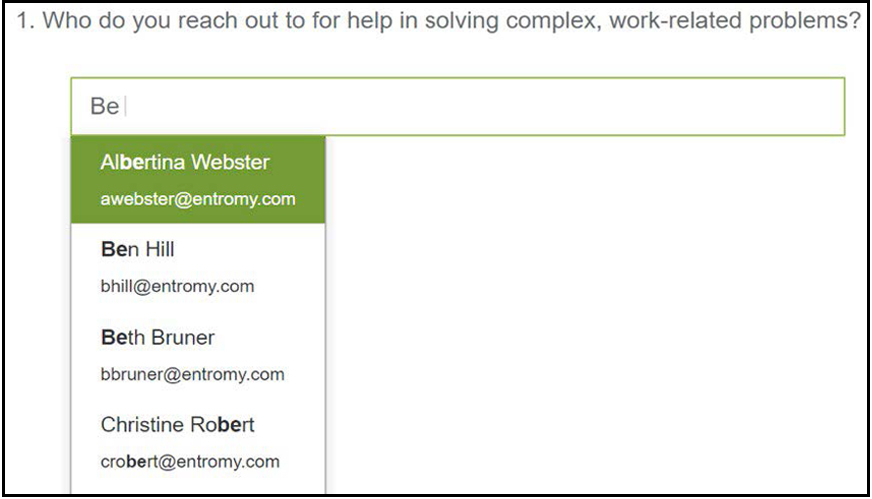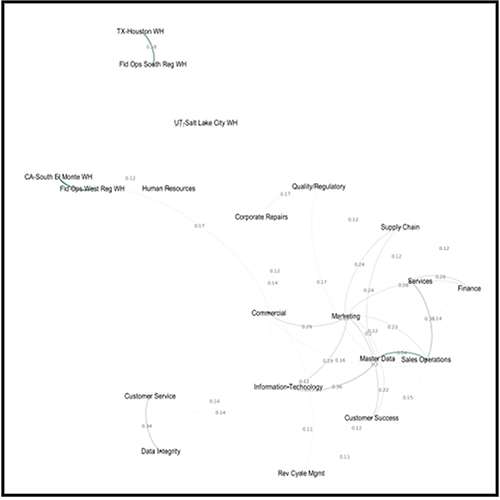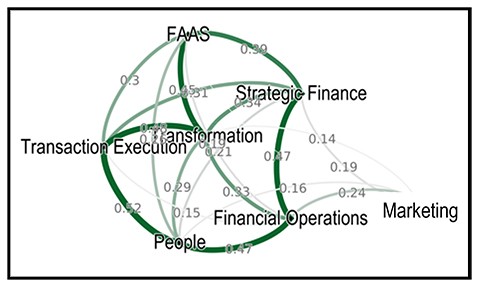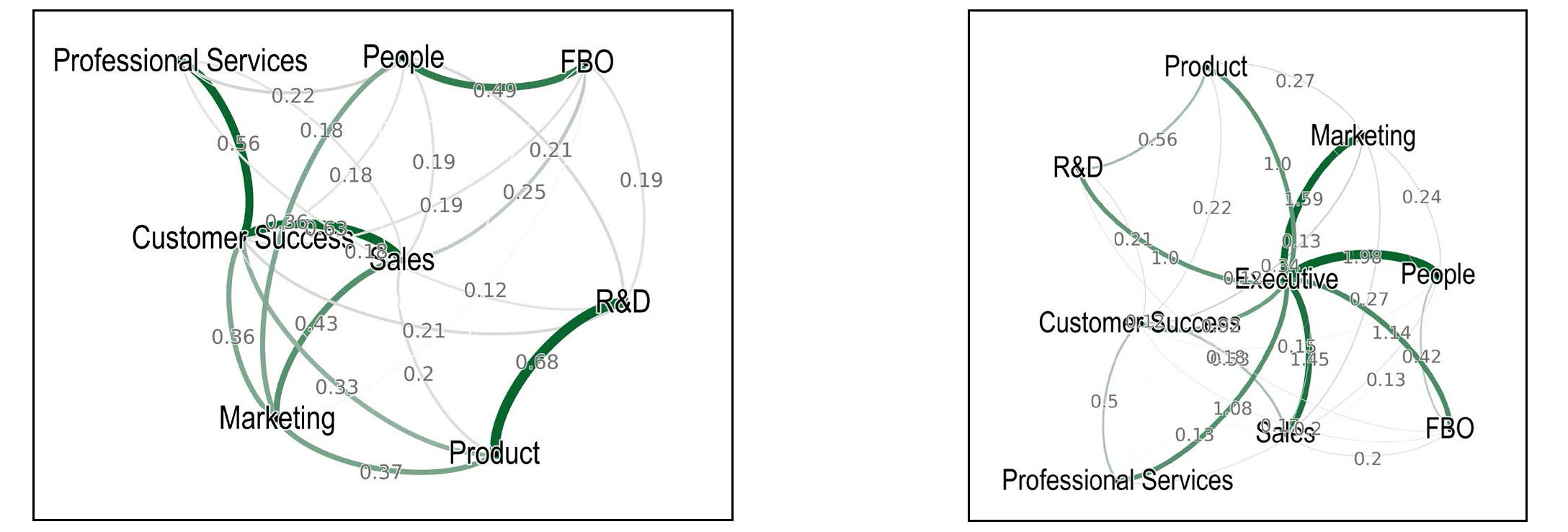How ONA Highlights Key Drivers of Organizational Performance
Organization network analysis (ONA) is a tool that helps leaders better understand the social structure of their workforce. Visualizing patterns of communication and collaboration can offer unique insight into how information flows and where centers of influence exist within the organization. It can also identify those to whom others go to for clarity, information, support, etc. ONA can also provide a sense for who the key leaders are within an organization and how integrated teams are across different organizational boundaries.
There are many ways to analyze an organizational network, including active and passive methods. Passive methods rely on meta-data collected from communication platforms (e.g., email, slack, etc.) to identify who is communicating with whom. Active methods ask participants who they go to for information on things like strategy, innovation, career advice, etc. (see Figure 1 for an example).
Figure 1: Sample ONA Questions

Entromy, a technology platform that informs executive decisions with rapid, consultant-quality organizational insights, uses an active method of ONA. By mapping outreach patterns across departments, leaders can gain a sense for where collaboration is strongest and weakest, where collaboration patterns line up with strategic priorities, and where organizational change may help improve effectiveness.
Summit Leadership Partners, a consulting firm that partners with growth-oriented companies and business leaders to scale and improve performance, incorporates ONA data into their advisory work to help unlock key sources of value.
Below, we describe three cases that illustrate where ONA and consultative expertise can converge to provide unique insights and interventions. Each of these three companies utilized Entromy’s organizational health survey with ONA capabilities and partnered with Summit to advise them on their growth needs, providing actionable recommendations on structure, talent, culture, and strategy.
“The Disconnected Company” is a healthcare company with a national footprint and a long operating history. After several years of declining results; however, they enacted a new strategic plan to return to profitable growth and improve employee engagement. When the consulting engagement began, the company was still struggling to achieve its growth plan and early conversations with the client suggested collaboration bottlenecks may be creating problems. During the engagement, we found:
- Key leaders often defined success and strategic priorities from the perspective of their own function versus the perspective of the enterprise as a whole.
- The lack of investment in cross-functional collaboration resulted in a fragmented culture, which made strategic alignment a sticking point.
- Entromy’s Organizational Health Baseline revealed only 33% of the workforce believed they effectively collaborated across functions, and ONA results (Figure 2) highlighted the silos within the company and revealed that 50% of the functions operated in isolation.
Summit leveraged this insight to provide actional recommendations that helped organizational leaders establish cross-functional meetings to build alignment and take steps toward unifying the culture, helping to view the organization as one as opposed to disjointed parts.
Figure 2: Company A, Organizational Network Results

“The Tightly Connected Company” is a financial advisory consultancy that underwent tremendous growth. Over the course of three years, the company grew from three practices in New York and San Francisco to eight practices operating in nine offices throughout the United States. Furthermore, the company recently made its first acquisitio. Ensuring the right structure, capabilities, and culture were in place was critical to their growth plan. We found:
- The Tightly Connected Company was on track to hit their growth plans and their Organizational Health Baseline results indicated their culture was a key reason for their continued success.
- Employees described the culture as their “secret sauce” when attracting, engaging, and retaining talent, and defined it as a low-ego, humble, entrepreneurial, and collaborative environment.
- ONA results (Figure 3) revealed tightly connected paths between functions illustrating a highly collaborative and communicative organization.
Summit assisted the company in codifying key rituals and practices that would ensure the culture remained a competitive advantage as the firm continued to scale and evolve.
Figure 3: Company B, Organizational Network Results

“The Hub and Spoke Organization” emerged as one of the fastest growing HR technology software companies in the past few years and was looking to expand their product and service portfolio while preparing for an initial public offering (IPO). Critical to IPO preparation is ensuring the right financial, organizational, and leadership capabilities are in place, supported by a scalable organization design and leadership team that can drive both organic and inorganic growth amidst the heightened scrutiny of the public markets. We found:
- Members of the executive team described an open and collaborative culture, and Organization Health Baseline results revealed a healthy organization scoring in the top quartile across all dimensions, which was not surprising given the company’s continued ability to meet and exceed growth plans while maintaining a strong culture.
- When speaking with individuals below the executive team level, employees suggested a somewhat less collaborative environment. Initial ONA results showed strong connections across functions (see Figure 4A), but when the executive team was included as a separate department and results were re-run, the ONA showed that much of the collaboration and communication was passing through the executive suite (see Figure 4B), suggesting departments may have been overly dependent on their executive leader to acquire information across the company and communicate it down.
To address this, Summit worked with the executive team to establish cross-functional groups below the ELT that were responsible for operating results. These groups were designed to meet on a regular cadence to share progress and explore ideas for how to address issues. Codifying the roles of leaders below the
ELT was important to ensuring leaders across the company were focused on the right initiatives at the right level
Figure 4A: Company C, Initial Organization Network Results Figure 4B: Company C, Updated Organization Network Results 
For both the disconnected and tightly connected companies, the ONA results provided further confirmation of what was uncovered using traditional means to explore organization health. For The Hub and Spoke company, however, the ONA results provided a unique picture of a seemingly healthy organization that actually had hidden silos that may have caused the organization to drift apart further as the firm continued to expand.
ONA is a tool that is simple to deploy and can provide unique insight into organizational culture. In high-growth companies it can help illuminate patterns of collaboration that may impact growth and can help identify cohorts of influencers who can help lead and champion organizational change. In organizations and industries characterized by frequent M&A activity, ONA can help identify followership patterns or where there may be key-person risk within an organizational hierarchy.
For more information on how Entromy and Summit are partnering to help organizations drive value contact us:
Kevin Impelman PhD
Director, Consulting Products & Services
kevin.impelman@summitleadership.com
Kristin Murphy PhD
Vice President, Private Equity & Partnerships
kristin.murphy@entromy.com